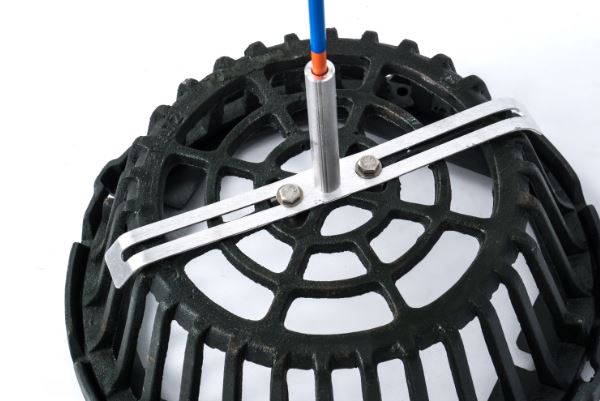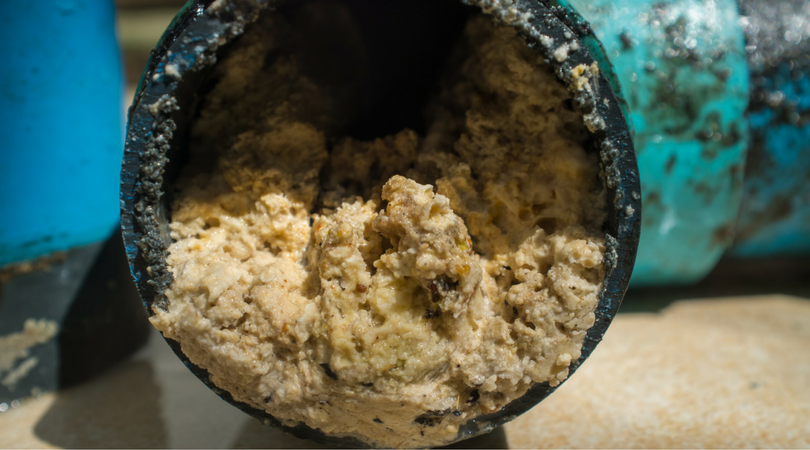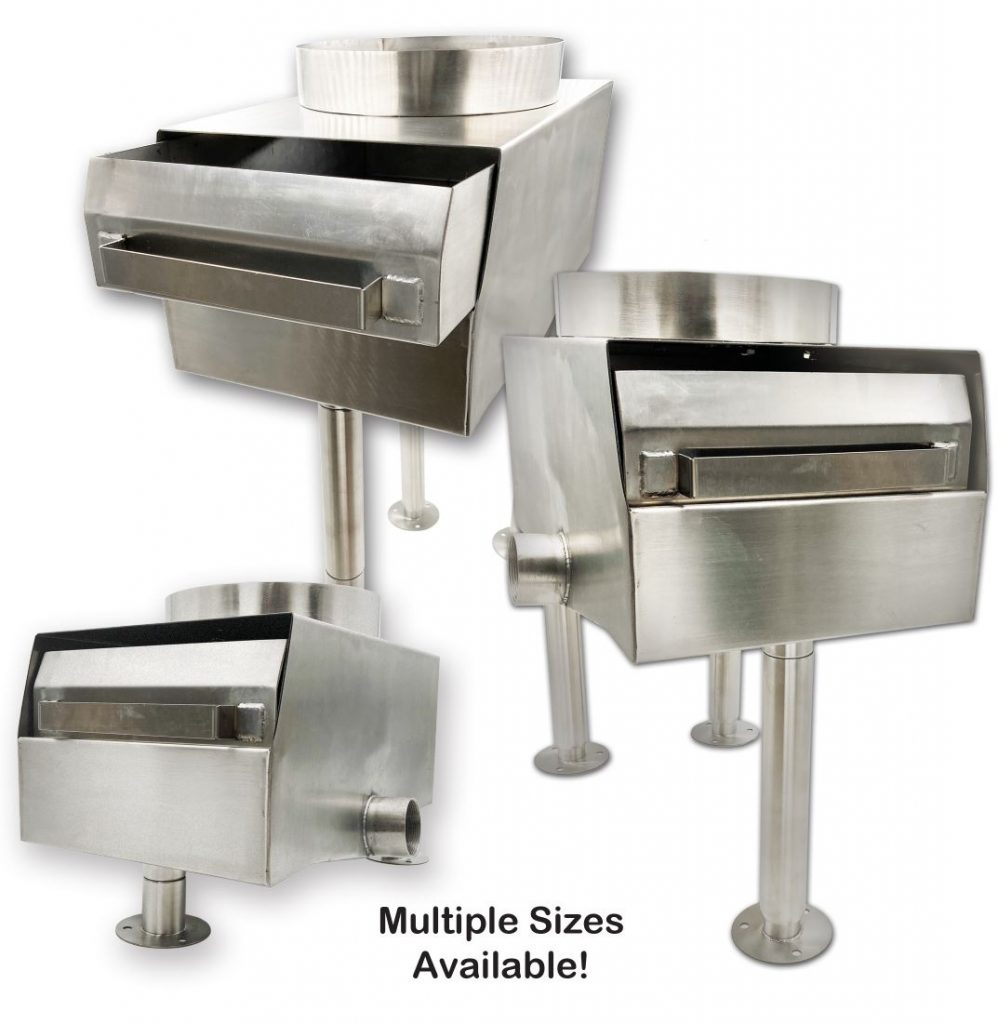Will pouring salt down the drain help clear my drains
There are a lot of old wives’ tales about homemade solutions to cleaning out clogged drains. One of them we’ve heard is pouring salt down drains. Or flushing boiling salt water down drains.
We recommend you don’t dry this. It can be potentially dangerous to pour boiling water into drains. Sure you might find a website or two that suggests this, but there certainly is no consensus on this idea from professional plumbers. Remember that salt can be a corrosive element and copper pipes are the most vulnerable to corrosion from exposure to salt water. The copper reacts with the salt, which can change the structure of the material. Galvanized steel and cast iron also react to salt water exposure, but they are a little more resistant than copper.
We suggest preventing drain problems all together using the many products we offer. Visit Drain-Tech.com to buy today!
Why commercial buildings need a roof drain marker during snow season
Remember last year’s almost snow-free winter in the Northeast? Well, this year our prediction is very different, with the possibility of a blizzard hitting the Mid-Atlantic and Northeast states during the second week of February. This storm may bring up to 1-2 feet of snow to cities from Washington, D.C. to Boston, Massachusetts!
The Great Lakes region will get its fair share of snow but expect above-normal snowfall if you live in the western Dakotas, northern portions of Colorado and Utah, as well as Wyoming, Montana, Idaho, and central and eastern sections of Washington and Oregon.
Eastern Ohio and Kentucky can expect a significant snowfall in the beginning of February, and the Southern Plains are on target to receive copious amounts of snow, sleet, and rain later on that same month.
And for those living in the eastern half of the country, you may get clobbered during the final week of March, but what falls from the sky will depend on where you live-this storm will track from the nation’s midsection to central New England and bring a significant late-season snowfall to the north of its track, and showers and thunderstorms to the south.

I like knowing we have a part in making the roof safer for those on it, and those in it when drains are tended to. Marine grade aluminum alloy impervious to fresh water applications matched with a sub assembly comprised of a high grade stainless steel that’s been scientifically paired best compatibility for corrosion resistance. A quality product that delivers year after year, storm after storm. Built to last the life of the roof!

Due diligence pays big dividends A safer, faster, more efficient way to identify your roof drains. Reversibility of our flags for better functionality.
Visit our website to purchase today!
“Drain markers worked and are still working well. Not only did they come in handy during the snow fall we had this winter, but also helping the trades guys keep track of cleaning the debris from the drains.” Wesleyan University“This product solves the problem of roof drain locations on flat roofs. It is durable, easy to install and reasonably priced. I highly recommend Roof Drain Markers!” Superintendent of Facilities Berlin, CT
“I highly recommend the markers. It was easy to identify the drains in the snow, and the guys said they were really easy to install. They hold up great. The flag markers are strong but flexible. They’re worth the investment and look really good on the roof.” Tufts University
“Very pleased with the cost savings on keeping our roof drains clear of snow & ice this past year since we installed the drain markers. Easily locating them makes a difference. We highly recommend Roof Drain Markers.” Federal Realty
What is causing my drain clog?
Here are the top five causes for drain and sewer stoppages and how you can avoid your home or business problems.
1. Grease – You might assume that washing an oily pan in the sink is harmless, but grease is one of the top culprits for clogging. Fatty materials can stick in your pipes and prevent waste material from moving through them properly. Although you may not eliminate grease from your plumbing, you should try to reduce the amount of oil and fat you put down the drain. The best way to dispose of grease is to let the oil or grease cool and solidify. Once cool and stable, scrape the fat into a container that you can throw away. Please place it in a plastic bag to prevent leakage and then throw it in the garbage when it is full. Restaurants need to ensure they are using a properly installed Grease Trap or Grease Interceptor.
2. Fibrous Foods – You should not overestimate the abilities of your garbage disposal. Putting tough, dense food scraps like potato skins, celery, eggshells, pasta, beans, or stringy vegetables down the drain can disrupt the blades and block the pipes. Try to go easy on your garbage disposal to keep it functioning properly and avoid a drainage disaster. There are also garbage disposal alternatives that restaurants and commercial facilities should consider: https://www.drain-tech.com/garbage-disposal-replacement/
3. Soap Scum – Over time, your shampoo, conditioner, and body wash can coat the edges of your pipes, gradually narrowing them until water and debris can no longer flow through them. Also, soap scum can latch on to lose hair and make them more likely to form clumps. For an easy, natural way to clean your drain pipes, pour 1 cup of baking soda down the drain, followed by 2 cups of boiling water. Let the mixture work for about 30 minutes, then use a plunger to break up any clogs.
4. Hygiene Products – Feminine items, floss, cotton pads, dental floss, and other hygiene products can seriously plug up your pipes. Make sure you follow the instructions on the packaging and only flush things that readily dissolve in water.
5. Hair – Lathering your locks in the shower or brushing your hair over the sink could contribute to clogging. Hairs can tangle and form clumps that obstruct your pipes. To prevent this from happening, make sure you use a hair catcher in your shower drain and sweep hair from your sink.
Doing your part will help ensure water can move efficiently and prevent pipes from getting clogged.
Pouring grease down your drain is a slippery slope to sewer problems
You may think that pouring fats, oils or grease down the kitchen sink is no big deal. A victimless crime, at worst.
However, Michael Mitchell has gotten up close and personal with the unpleasant consequences of grease accumulating in Ottawa’s sewers. He can tell you that when it comes to what you pour down the drain, out of sight does not mean out of mind.
It’s Michael’s job to ensure that wastewater from your home travels efficiently through Ottawa’s sewer system to the City’s wastewater treatment facility.
When congealed grease builds up and gets lodged somewhere along the City’s 3,000 kilometres of sewer pipes, Michael knows it’s time to clear his calendar.
How does grease buildup affect your ability to maintain City sewers?
Grease buildup extends a one-day job into multiple days. It means extra staffing, contractor time, and bringing in all sorts of specialized equipment.
Typically, we clean pipes using high-pressure water, but when these grease build-ups happen, we have to use nozzle attachments with chain-cutters that rotate at high speed to scrape grease from the pipe walls. It takes a long time, but it gets the job done.
Are there any impacts on the pipes themselves?
Absolutely. Clogs aren’t the only issue. People might not know this, but grease corrodes and degrades the walls of a pipe over time. There’s also damage to the sewer system itself. When you have to replace a corroded pipe, that comes at a cost to taxpayers.
Visit Drain-Tech.com to help prevent drain clogs due to grease and solids!
What’s the worst grease-related incident you’ve seen?
I’ve seen a 24-inch pipe that was completely blocked with grease – the blockage was over eight meters long. Over time, the grease had completely eaten away the bottom of the pipe.
We use a remote-controlled robotic camera with mud-tires, called a CCTV robot. When we sent it into the pipe to have a look, it fell right through the hole. We had to excavate to retrieve it, which was another big job. The CCTV camera has a seriously dirty job. It will emerge from a pipe totally covered in grease. Better him than me!

Read the full story at: https://ottawa.ca/en/news/pouring-grease-down-your-drain-slippery-slope-sewer-problems-1
Commercial Foodservice Disposers – Cleaning, Maintenance and replacement
Disposers in commercial foodservice operations can help reduce trash-hauling costs by decreasing waste, eliminating food waste odors and decreasing labor by minimizing trips to the dumpster. Disposers often come with a control, sink or sink mount for existing sinks, stopper, water inlet hardware, back flow preventer, solenoid valve and flow control.
This equipment is typically installed in dish tables and pot/pan sinks as well as in vegetable prep, salad prep and meat prep areas. While a commercial disposer is more durable than the residential type and is capable of grinding more items, manufacturers still recommend using these units only for edible food waste. This is because some waste, such as corn husks and seafood shells, can clog drains…
It’s important to note that the disposal of any effluent into municipal wastewater (sewer) systems is typically governed under municipal by-laws/ordinances and enforced at the local level or through a regional municipal authority, in accordance with state and federal environmental legislation. These ordinances detail permissible limits of various materials and chemicals that can be present in effluent that is being disposed of into the municipal waste water system, and that ultimately need to be processed and treated at the wastewater treatment plant…
Cleaning and Maintenance
Operators should consider a variety of factors when it comes to the use and maintenance of disposers. First, do not use these systems to dispose fat, oil and grease. Also, batch feeding food waste into disposers blocks water, resulting in drain line clogs. For clogs, fill a 5-gallon bucket with cold water and run it through the disposer to push waste through.
After feeding product through the disposer, operators should allow cold water to run for 10 to 20 seconds to ensure small particles push to the main sewer line. Do not use hot water as doing so can melt fat and allow it to solidify and block the drain line. Keep plastics, silverware, straws and other non-food items away from the disposer to minimize jams.
Only use disposers with the appropriate food waste. Some food scraps, like potato skins, can build a layer inside the unit and dull the blades quicker. This also turns into a paste that drags motors down. Also, the higher the horsepower, the more volume the disposer can handle. It also helps to start and stop the unit as much as possible since the blades go in different directions when power is interrupted.
Many people think disposers have blades that spin, but this isn’t the case. These units use two weighted pieces on a spinning disk that throws food onto blades at the sides of the machine. Putting inappropriate food waste down disposers can clog the drain and grease trap, which is difficult to empty out…
Read the full article at: https://fesmag.com/products/guide/sanitation-and-safety/disposers/17910-disposers
Should I replace my Garbage Disposer?
The life expectancy of a disposer depends on the type of food it grinds, the food’s composition and how long the unit is in operation. Life cycles range from 3 years up to 20 years, with an average service life of 5 years for disposers that are cleaned and properly maintained.
Signs that indicate a disposer needs replacing include increased grind time, which can be caused by blades wearing out, motor failure or smoke, cracks, unusual or excess noise, and frequent repairs.
Commercial disposers that are 5 HP and up can be rebuilt, but with smaller units, too many things can go wrong, and it’s not worth the cost. Also, disposers with leaks in seals or shafts should be
But we suggest that you don’t replace a Garbage Disposer with another one that will just break again. Get the Garbage Disposer alternative: The A6 Wet Waste Interceptor!

Our Garbage Disposal Replacement Strainers (also called wet waste interceptors) separate solid food particles and water in commercial kitchen sinks. Dishwasher sinks, 3-compartment sinks, and other commercial sinks have to be able to handle large amounts of food waste which can cause drain backups and plumbing clogs. These wet waste interceptors improve drain line and grease trap efficiency.
These products are a great alternative to electric garbage disposals because they do not require electricity and do not have dangerous mechanical parts. These products are sometimes referred to as food scrap collectors, flat strainers, and garbage disposal replacement unites. Whatever you call them, make sure your plumbing problems are a thing of the past!
Learn more at: https://www.drain-tech.com/garbage-disposal-replacement/


